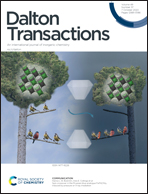Cu-Catalyzed P–C bond formation/cleavage: straightforward synthesis/ring-expansion of strained cyclic phosphoniums†
Abstract
Upon reaction with copper(I), peri-halo naphthyl phosphines readily form peri-bridged naphthyl phosphonium salts. The reaction works with alkyl, aryl and amino substituents at phosphorus, with iodine, bromine and chlorine as a halogen. It proceeds under mild conditions and is quantitative, despite the strain associated with the resulting 4-membered ring structure and the naphthalene framework. The transformation is amenable to catalysis. Under optimized conditions, the peri-iodo naphthyl phosphine 1-I is converted into the corresponding peri-bridged naphthyl phosphonium salt 2b in only 5 minutes at room temperature using 1 mol% of CuI. Based on DFT calculations, the reaction is proposed to involve a Cu(I)/Cu(III) cycle made of P-coordination, C–X oxidative addition and P–C reductive elimination. This copper-catalyzed route gives a general and efficient access to peri-bridged naphthyl phosphonium salts for the first time. Reactivity studies could thus be initiated and the possibility to insert gold into the strained P–C bond was demonstrated. It leads to (P,C)-cyclometallated gold(III) complexes. According to experimental observations and DFT calculations, two mechanistic pathways are operating: (i) direct oxidative addition of the strained P–C bond to gold,(ii) backward-formation of the peri-halo naphthyl phosphine (by C–P oxidative addition to copper followed by C–X reductive elimination), copper to gold exchange and oxidative addition of the C–X bond to gold. Detailed analysis of the reaction profiles computed theoretically gives more insight into the influence of the nature of the solvent and halogen atom, and provides rationale for the very different behaviour of copper and gold in this chemistry.



 Please wait while we load your content...
Please wait while we load your content...